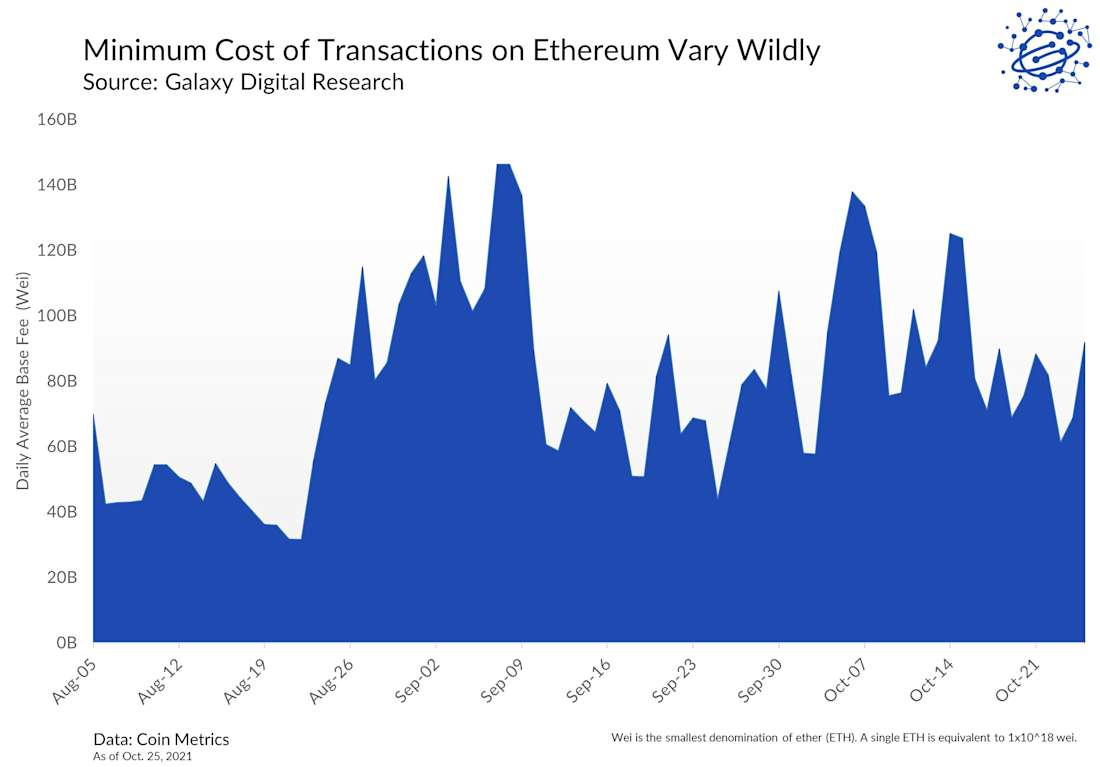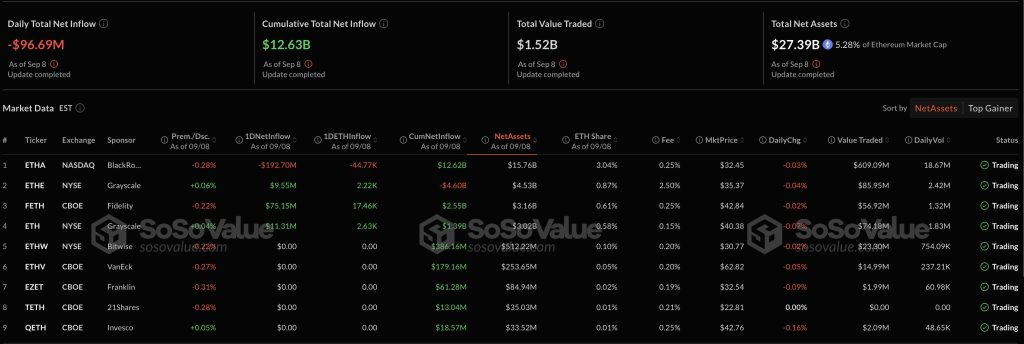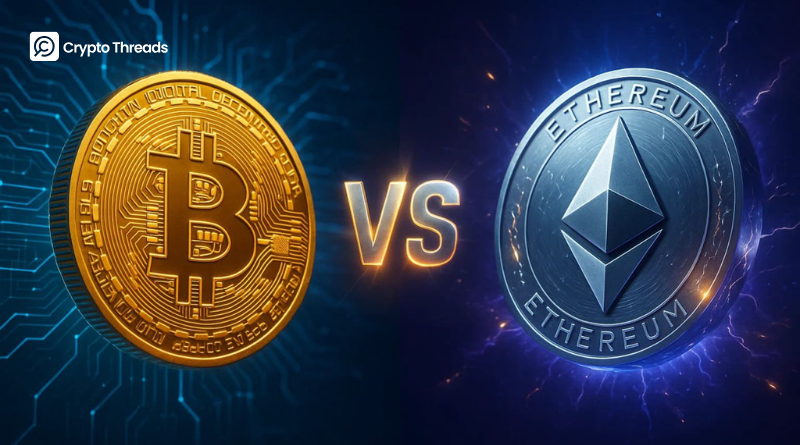Ethereum vs Bitcoin: Key Differences Explained
Key Takeaways:
- Bitcoin secures value through scarcity and stability.
- Ethereum drives innovation with smart contracts and dApps.
- Bitcoin acts as digital gold, Ethereum as digital infrastructure.
- Institutions use Bitcoin as a hedge, Ethereum as a growth asset.
- Their futures are complementary, one anchors wealth, the other expands economies.
No conversation about cryptocurrency can avoid the names Bitcoin and Ethereum. They dominate headlines, market charts, and institutional reports, representing together more than half of the total crypto market capitalization. Yet they are often misunderstood as competitors vying for the same throne. But the truth is more subtle and more interesting.
This article will explore the truth about Ethereum vs Bitcoin, showing how they diverge in design, purpose, and impact. Instead of asking which one is better, the focus is on what sets them apart. Together, they anchor the crypto ecosystem, each in its own way.
Bitcoin and Ethereum Origins: Revolution vs Expansion
Bitcoin’s creation in 2009 was a direct response to the global financial crisis. At a time when governments were printing money and bailing out banks, Bitcoin offered a radical alternative: a fixed-supply, decentralized currency immune to manipulation. Its anonymous creator, Satoshi Nakamoto, embedded in Bitcoin’s code a message referencing a bank bailout. Bitcoin’s DNA was forged in distrust of centralized power, and this ethos continues to define its culture today.

Ethereum’s origins tell a different story. In 2015, Vitalik Buterin and his co-founders saw potential in blockchain that Bitcoin did not address. Instead of limiting the system to money transfers, they imagined a “world computer” where code could execute automatically on a decentralized network. Ethereum’s launch was less about protest and more about possibility: if Bitcoin answered the question of how to create trustless money, Ethereum asked how to build trustless applications.
This divergence in origin still echoes today. Bitcoiners emphasize resilience and resistance to change, while Ethereum’s community celebrates innovation and adaptability. Ethereum vs Bitcoin is, at its root, a story of revolution versus expansion: one designed to overthrow a broken financial system, the other designed to reimagine what digital infrastructure can become.
Bitcoin and Ethereum Technology: Fortress vs Laboratory
The technical differences between Bitcoin and Ethereum highlight their opposing priorities. Bitcoin uses proof of work, where miners compete to solve cryptographic puzzles in order to validate transactions. This mechanism is energy-intensive, but it makes Bitcoin incredibly secure. Each block is added roughly every ten minutes, creating a system that prioritizes reliability over speed. Its scripting language is deliberately narrow, preventing complexity and limiting the attack surface. Bitcoin’s technology is like a fortress: solid, difficult to penetrate, and designed for one purpose only — to secure value.

Ethereum’s technology moves in the opposite direction. Originally built on proof of work, it transitioned to proof of stake in 2022, replacing mining with validators who secure the network by staking ETH. This reduced energy consumption by more than 99 percent and allowed Ethereum to scale more effectively. Its blocks are confirmed every twelve seconds, making it better suited for high-volume activity. Most importantly, Ethereum introduced Solidity, a flexible programming language that lets developers write complex smart contracts. This design choice turned Ethereum into a laboratory of innovation, where experimentation is encouraged and complexity is embraced.

This contrast explains why most decentralized finance, NFTs, and tokenized assets thrive on Ethereum while Bitcoin remains largely limited to payment and storage functions. Ethereum’s architecture is built for flexibility, while Bitcoin’s is built for permanence. In the ongoing Ethereum vs Bitcoin debate, one represents unshakable stability, the other boundless adaptability.
Opposite Monetary Design: Fixed Scarcity vs Adaptive Supply
One of the most striking differences in Ethereum vs Bitcoin is their approach to monetary policy. Bitcoin has a hard supply cap of 21M+coins, written into its code. This scarcity is its defining feature, and it ensures that Bitcoin is immune to inflation. Investors trust that Bitcoin’s supply will never change, making it comparable to gold but with the advantages of being digital, portable, and divisible. This predictability attracts long-term holders who view Bitcoin as a hedge against government money-printing and economic uncertainty.
Ethereum takes a more dynamic approach. It does not have a fixed cap, but since the introduction of EIP-1559 in 2021, a portion of transaction fees is burned permanently. Combined with proof of stake, this has created conditions where Ethereum often becomes deflationary, especially during periods of high network activity. Instead of enforcing scarcity rigidly, Ethereum balances supply with demand, creating an adaptive form of digital money. This design reflects its philosophy: not to be a store of value alone, but also to act as fuel for decentralized applications (dApps).

These differences shape how each asset is perceived. Bitcoin’s value proposition lies in its certainty, while Ethereum’s strength lies in its flexibility. Bitcoin is digital gold; Ethereum is programmable oil. Both appeal to investors in very different ways.
Different Purposes: Wealth Preservation vs Wealth Creation
Bitcoin’s purpose is straightforward: it exists to protect and transfer value without intermediaries. For many, it serves as a long-term store of wealth and a hedge against inflation. Its simplicity is intentional. Even developments like the Lightning Network, which allows faster payments, don’t alter Bitcoin’s core identity. Bitcoin is designed to be money: nothing more, nothing less. Its minimalism is a feature, not a limitation.

Ethereum’s purpose is far more expansive. By enabling smart contracts, Ethereum turned blockchain into a platform for creating new forms of value. It powers decentralized finance, where lending, borrowing, and trading occur without banks. It hosts NFTs, enabling digital art, collectibles, and gaming economies. It supports decentralized autonomous organizations, where communities govern themselves through code. More recently, Ethereum has become central to the tokenization of real-world assets like real estate and bonds. Where Bitcoin preserves wealth, Ethereum creates entirely new markets.
This difference explains why developers, artists, and entrepreneurs gravitate toward Ethereum, while conservative investors often prefer Bitcoin. Ethereum vs Bitcoin is not just a choice of assets; it is a choice between a system that protects value and one that multiplies possibilities.
Security: Immutable Strength vs Economic Incentives
Security is the bedrock of both systems, but the way they achieve it diverges. Bitcoin’s proof-of-work model is battle-tested. Its immense hash power makes attacking the network prohibitively hard. Combined with its conservative governance, Bitcoin’s security is anchored in immutability. Very little changes, and that is precisely why it works. The cost of breaking Bitcoin’s security is astronomical, making it the most secure blockchain in existence.

Ethereum’s proof-of-stake system secures the network through economic incentives. Validators must lock up ETH, and if they behave dishonestly, they risk losing their stake. This creates a different kind of resilience: one rooted in game theory rather than raw energy consumption. It is more sustainable but also more complex. Ethereum’s security model evolves alongside its network, adapting to new demands and threats.
This contrast reflects their broader philosophies. Bitcoin maintains security by resisting change; Ethereum maintains it by adapting. Both are effective, but they appeal to different worldviews. Bitcoin offers the reassurance of permanence; Ethereum offers the promise of progress.
Governance: Slow Consensus vs Agile Upgrades
Governance illustrates the cultural divide in Ethereum vs Bitcoin. Bitcoin’s governance is famously cautious. To change the protocol, near-universal agreement is required across miners, developers, and users. This slow, consensus-driven process means upgrades are rare and incremental. The result is stability and predictability, but also limited flexibility. Bitcoin’s community values preservation over experimentation.
Ethereum’s governance, while still decentralized, is more agile. Guided by the Ethereum Foundation and a vibrant developer community, it regularly implements upgrades to improve scalability, usability, and efficiency. From the Merge to planned upgrades like sharding and danksharding, Ethereum evolves continuously. Its community embraces debate and experimentation, even if it means moving quickly.
These differing governance models reflect their identities. Bitcoin’s slow governance ensures its mission never drifts, while Ethereum’s agility keeps it relevant as technology and markets change. For users, this means Bitcoin is dependable, while Ethereum is dynamic.
Scalability: Narrow Focus vs Expansive Solutions
Scalability is another area where Bitcoin and Ethereum diverge sharply. Bitcoin’s scalability solution is the Lightning Network, a second-layer protocol that allows instant, low-fee payments. Lightning works well for payments and could make Bitcoin more practical as digital cash, but its scope is limited to transactions.
Ethereum, facing demand from thousands of decentralized applications, has developed a far more expansive scalability strategy. Its ecosystem of layer-two networks, including Arbitrum, Optimism, and zkSync, process large volumes of transactions off-chain before settling them back on the Ethereum base layer. This modular design allows Ethereum to handle everything from financial protocols to gaming platforms, all at scale.
In short, Bitcoin scales payments, Ethereum scales economies. This difference underscores their contrasting ambitions: one seeks to improve money, the other to expand the entire digital economy.
Environmental Impact: Energy Debate vs Green Transition
Bitcoin’s energy consumption is one of its most debated features. Its proof-of-work model uses electricity equivalent to that of small countries. Critics see this as wasteful, while supporters argue that it secures the network and drives investment in renewable energy. For Bitcoiners, the energy cost is not a flaw but a feature — a proof of security and commitment.
Ethereum took a very different path. With its transition to proof of stake, Ethereum reduced its energy use by over 99%, positioning itself as an environmentally sustainable blockchain. This change has made it far more attractive to institutions and regulators focused on ESG standards. In terms of environmental impact, Ethereum has already redefined the narrative, while Bitcoin continues to defend its model as necessary for ultimate security.
The difference highlights how Ethereum vs Bitcoin reflects not just technology but values. Bitcoin defends energy as a security trade-off, while Ethereum embraces efficiency as a path to mass adoption.
Institutional Adoption: Hedge vs Growth Engine
Institutional capital has continued to pour into Bitcoin during 2025, reinforcing its reputation as a defensive asset. In the first half of the year, U.S. spot Bitcoin ETFs attracted more than $14.8 billion in net inflows, already outpacing much of the growth seen in 2024. On September 12 alone, these ETFs recorded about $553 million in new investments, led by BlackRock’s IBIT with roughly $366 million and Fidelity’s FBTC with around $134 million. Such figures show how strongly institutions are leaning on Bitcoin as digital gold.

About Ethereum’s inflows, we can see a different story. In the week of September 8–12, 2025, Ethereum spot ETFs brought in $638 million, with Fidelity’s FETH alone accounting for $381 million. By September, total inflows across Ethereum ETFs had reached nearly $13.4 billion since launch. Beyond the numbers, what matters is the structure of these products: unlike Bitcoin ETFs, Ethereum vehicles can be paired with staking, offering yields in the 3–6% range. This makes Ethereum more than a growth asset; it becomes a productive one that combines exposure to innovation with a steady income stream.
Thus, these trends underline the institutional logic behind Ethereum vs Bitcoin. Bitcoin sits in portfolios as the stabilizer, the digital equivalent of a hedge. Ethereum, by contrast, is treated as a growth play, providing exposure to the expanding decentralized economy and the chance to capture yield. For portfolio managers, the real power comes from holding both: Bitcoin for ballast, Ethereum for upside.
Market Dynamics: Stability vs Volatility
Market behavior reinforces the contrast. Bitcoin often leads the market, setting the tone for cycles. Its price movements are less volatile, making it a safer haven during downturns. Ethereum, while correlated, tends to amplify trends. It rises higher in bull markets and falls faster in bears. This volatility reflects its role as a growth asset tied to innovation and experimentation.
For investors, the strategy often becomes clear: hold Bitcoin as the stabilizer, and Ethereum as the amplifier. Together, they provide balance: one anchors wealth, the other seeks upside. Ethereum vs Bitcoin, in this sense, is not just a theoretical debate but a practical portfolio decision.
Philosophical Divide: Money vs Machine
At the deepest level, Ethereum vs Bitcoin embodies two philosophies. Bitcoin is sound money, immutable and resistant to change. Its role is to preserve value in a trustless system. It rejects complexity, favoring simplicity as the ultimate defense.
Ethereum is a world computer, designed for constant evolution. It embraces complexity, programmability, and the idea that blockchain can underpin entire digital societies. Bitcoin is minimalism; Ethereum is maximalism. One is money outside the state, the other is infrastructure for a decentralized future.
This philosophical divide is why both continue to thrive. They do not compete for the same purpose. They coexist as two sides of the blockchain revolution: one defending wealth, the other creating new possibilities.
Looking Ahead: Complementary Futures
By 2030, both Bitcoin and Ethereum are poised to remain at the center of the digital economy. Bitcoin is set to strengthen its position as the reserve asset of the internet age, serving as digital gold for a world searching for stability beyond traditional currencies. Meanwhile, Ethereum will likely broaden its reach as the infrastructure of decentralized systems, powering finance, governance, culture, and tokenized real-world assets.
Their paths point toward coexistence. Bitcoin anchors digital scarcity with its predictable design, while Ethereum layers innovation on top by enabling programmable economies. Viewed together, Ethereum vs Bitcoin is better understood as a partnership of forces: one providing the foundation, the other driving expansion.
Frequently Asked Questions
1. What is the main difference between Bitcoin and Ethereum?
Bitcoin was created as digital money with a fixed supply, making it a store of value. Ethereum is a programmable blockchain that powers apps, smart contracts, and DeFi. Bitcoin protects wealth, while Ethereum expands what blockchain can do.
2. Why is Bitcoin called digital gold?
Bitcoin’s supply is limited to 21 million coins, which makes it scarce. Like gold, it is trusted to hold value and hedge against inflation. Investors mainly use it for long-term preservation, not daily spending.
3. Can Ethereum be used as money?
Yes, ETH can be used for payments, but its bigger role is powering apps on its network. Every action on Ethereum, from trading tokens to running DeFi, needs ETH as fuel. That makes it both money and infrastructure.
4. What is Proof of Work vs Proof of Stake?
Bitcoin uses proof of work, where miners secure the network by using computing power. Ethereum switched to proof of stake in 2022, where validators lock ETH to validate blocks. This change cut its energy use by more than 99%.
5. Why are Ethereum fees high?
Fees rise when many people compete to use the network. During busy times like NFT launches, costs can spike quickly. Upgrades such as EIP-1559 made fees more predictable, but demand still keeps them high.
6. Is Ethereum deflationary?
Sometimes. Since EIP-1559, part of every fee is burned, reducing supply. When usage is high, more ETH is destroyed than created.
7. Which is better for beginners? Bitcoin or Ethereum?
Bitcoin is simpler to understand and often a starting point. Ethereum offers more features, but it can feel complex at first. Many beginners hold some of both.
8. What are Bitcoin and Ethereum ETFs?
They are stock market funds that track BTC or ETH prices. Bitcoin ETFs launched in 2024, while Ethereum ETFs came in 2025 with added staking yields. These products make crypto easier to access for institutions and retail investors.
9. Will Ethereum replace Bitcoin?
No. Bitcoin is focused on scarcity and security, while Ethereum drives apps and innovation. They solve different problems and work better together.
10. Is investing in Bitcoin and Ethereum safe?
Both are the most established cryptos, but prices remain volatile. Bitcoin is generally steadier, while Ethereum carries more upside and risk. Always invest with a long-term view.
Conclusion: Two Visions, One Future
The story of Ethereum vs Bitcoin is often told as competition, but in practice it reflects two visions working side by side. Bitcoin embodies scarcity, security, and permanence. Ethereum embodies flexibility, creativity, and growth. Each appeals to a different mindset: one focused on preservation, the other on opportunity.
For investors and builders alike, the lesson is straightforward. Bitcoin secures value much like gold, while Ethereum multiplies possibilities much like infrastructure. Together, they form the twin pillars of the crypto era: distinct in purpose, yet essential in shaping the next chapter of global finance.



